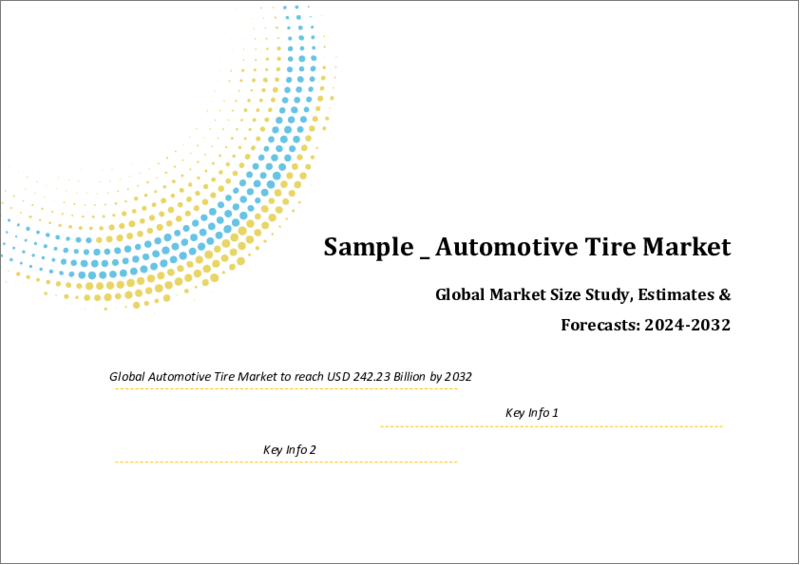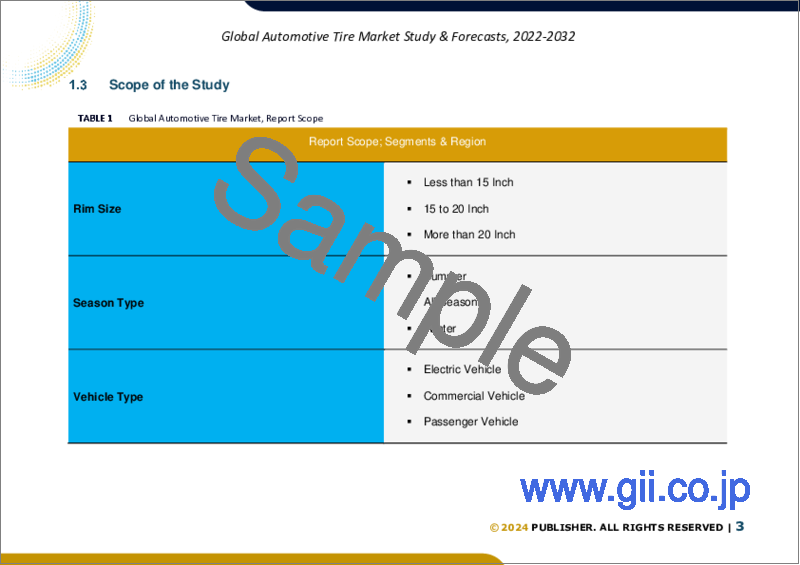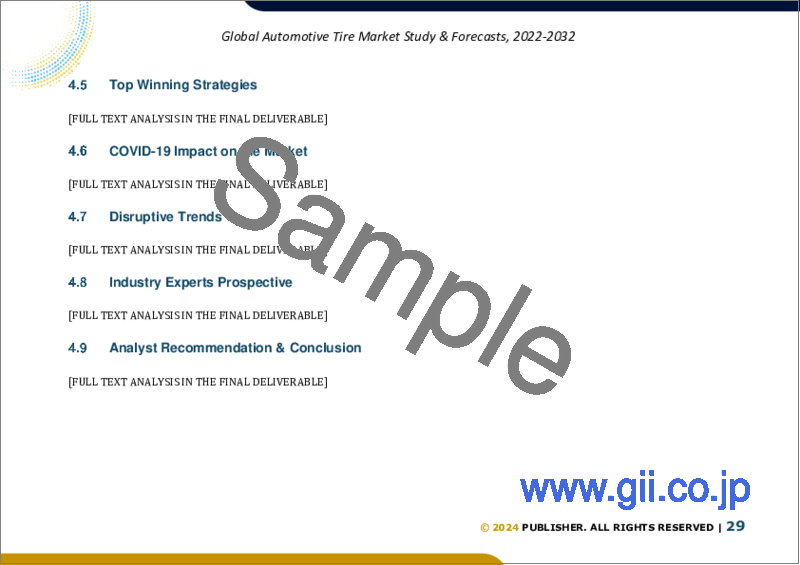|
|
市場調査レポート
商品コード
1514804
自動車用タイヤの世界市場規模調査:リムサイズ別、シーズンタイプ別、車両タイプ別、ロードインデックス別、地域別、2022年~2032年の予測Global Automotive Tire Market Size Study, by Rim Size, by Season Type, by Vehicle Type, by Load Index and Regional Forecasts 2022-2032 |
||||||
カスタマイズ可能
|
|||||||
| 自動車用タイヤの世界市場規模調査:リムサイズ別、シーズンタイプ別、車両タイプ別、ロードインデックス別、地域別、2022年~2032年の予測 |
|
出版日: 2024年07月11日
発行: Bizwit Research & Consulting LLP
ページ情報: 英文 200 Pages
納期: 2~3営業日
|
全表示
- 概要
- 目次
自動車用タイヤの世界市場は、2023年に約1,534億9,000万米ドルと評価され、予測期間2024年から2032年にかけて5.2%以上の健全な成長率で成長すると予測されています。
自動車用タイヤは、車両と路面との接点となるシャーシの重要な部品です。タイヤは、さまざまな環境条件や路面からのストレスに耐えられるよう、ゴム、布、スチールを組み合わせて、特定の性能要件を満たすように綿密に設計・製造されています。これらの部品は、グリップ、ハンドリング、耐久性などの性能特性を最適化し、車両の安全性、燃費効率、全体的な運転の快適性を保証します。オールシーズンタイヤ、サマータイヤ、ウィンタータイヤなど、多様な種類のタイヤがさまざまな走行条件や嗜好に対応し、自動車の性能と安全性におけるタイヤの重要性を際立たせています。
高性能タイヤに対する消費者需要の高まり、新興国市場での自動車生産の増加、燃費効率と環境持続可能性の重視により、市場は大きく成長するとみられます。電気自動車の採用、タイヤ設計と材料の革新、タイヤのリサイクルと持続可能性の重視は、市場成長を促進する主な要因です。しかし、原材料価格の変動、消費者の嗜好の変化、厳しい規制基準が課題となっています。とはいえ、タイヤ製造における技術の進歩と自動車産業の成長は、大きな成長機会をもたらしています。
COVID-19パンデミックの初期段階は、製造およびサプライ・チェーンの混乱につながり、タイヤ生産が一時的に減少しました。操業停止や規制は世界のモビリティに影響を与え、自動車販売台数の減少、ひいてはタイヤ需要の減少を引き起こしました。経済の不確実性は個人消費に影響を与え、タイヤの交換やアップグレードを遅らせた。経済が再開し、自動車部門が回復すると、個人輸送に再び注目が集まり、タイヤ市場の回復を促しました。パンデミックはまた、弾力性のあるサプライチェーンの重要性を浮き彫りにし、メーカーに生産プロセスの最適化を促しました。
アジア太平洋地域は、急速な経済成長と工業化により、市場収益の最大シェアを占めています。タイヤ需要は、新興国市場の拡大、都市化の進展、インフラ整備によって牽引されています。多様な走行条件が様々な種類のタイヤを必要とし、市場の成長を後押ししています。電気自動車や持続可能なモビリティへのシフトはタイヤの嗜好に影響を与え、環境に優しく燃費の良いオプションが求められています。生産施設と流通網を確立するためのメーカーの戦略的イニシアチブは、この地域での市場拡大をさらに後押ししています。
目次
第1章 自動車用タイヤの世界市場エグゼクティブサマリー
- 自動車用タイヤの世界市場規模・予測(2022-2032年)
- 地域別概要
- セグメント別概要
- リムサイズ別
- シーズンタイプ別
- 車両タイプ別
- ロードインデックス別
- 主要動向
- 景気後退の影響
- アナリストの結論・提言
第2章 世界の自動車用タイヤ市場の定義と調査前提条件
- 調査目的
- 市場の定義
- 調査前提条件
- 包含と除外
- 制限事項
- 供給サイドの分析
- 入手可能性
- インフラ
- 規制環境
- 市場競争
- 経済性(消費者の視点)
- 需要サイド分析
- 規制の枠組み
- 技術の進歩
- 環境への配慮
- 消費者の意識と受容
- 調査手法
- 調査対象年
- 通貨換算レート
第3章 自動車用タイヤの世界市場力学
- 市場促進要因
- 高性能タイヤに対する消費者需要の増加
- 新興諸国における自動車生産の増加
- 燃費効率と環境持続可能性の重視
- 市場の課題
- 原材料価格の変動
- 消費者の嗜好の変化
- 厳しい規制基準
- 市場機会
- タイヤ製造技術の進歩
- 自動車産業の成長
- 電気自動車の増加
第4章 自動車用タイヤの世界市場産業分析
- ポーターのファイブフォースモデル
- 供給企業の交渉力
- 買い手の交渉力
- 新規参入業者の脅威
- 代替品の脅威
- 競争企業間の敵対関係
- ポーターのファイブフォースモデルへの未来的アプローチ
- ポーターのファイブフォースの影響分析
- PESTEL分析
- 政治
- 経済
- 社会
- 技術
- 環境
- 法律
- 主な投資機会
- 主要成功戦略
- 破壊的動向
- 業界専門家の視点
- アナリストの結論・提言
第5章 自動車用タイヤの世界市場規模と予測:リムサイズ別、2022年~2032年
- セグメントダッシュボード
- 自動車用タイヤの世界市場:収益動向分析、2022年・2032年
- 15インチ未満
- 15~20インチ
- 20インチ以上
第6章 自動車用タイヤの世界市場規模と予測:シーズンタイプ別、2022年~2032年
- セグメントダッシュボード
- 自動車用タイヤの世界市場:収益動向分析、2022年・2032年
- 夏季
- オールシーズン
- 冬季
第7章 自動車用タイヤの世界市場規模と予測:車両タイプ別、2022年~2032年
- セグメントダッシュボード
- 自動車用タイヤの世界市場:収益動向分析、2022年・2032年
- 電気自動車
- 商用車
- 乗用車
第8章 自動車用タイヤの世界市場規模と予測:ロードインデックス別、2022年~2032年
- セグメントダッシュボード
- 自動車用タイヤの世界市場:収益動向分析、2022年・2032年
- 100まで
- 100以上
第9章 自動車用タイヤの世界市場規模と予測:地域別、2022年~2032年
- 北米
- 米国
- カナダ
- 欧州
- 英国
- ドイツ
- フランス
- スペイン
- イタリア
- その他欧州
- アジア太平洋
- 中国
- インド
- 日本
- オーストラリア
- 韓国
- その他アジア太平洋地域
- ラテンアメリカ
- ブラジル
- メキシコ
- その他ラテンアメリカ
- 中東・アフリカ
- サウジアラビア
- 南アフリカ
- その他中東とアフリカ
第10章 競合情報
- 主要企業のSWOT分析
- 主要市場戦略
- 企業プロファイル
- Bridgestone Corporation
- 主要情報
- 概要
- 財務(データの入手可能性によります)
- 製品概要
- 市場戦略
- Continental AG
- The Goodyear Tire & Rubber Company
- Hankook & Company Co., Ltd.
- Michelin
- Nokian Tyres Plc
- Pirelli & C. S.P.A
- Sumitomo Rubber Industries, Ltd.
- The Yokohama Rubber Co., Ltd.
- Toyo Tire Corporation
- Bridgestone Corporation
第11章 調査プロセス
- 調査プロセス
- データマイニング
- 分析
- 市場推定
- 検証
- 出版
- 調査属性
The Global Automotive Tire Market is valued approximately at USD 153.49 billion in 2023 and is anticipated to grow with a healthy growth rate of more than 5.2% over the forecast period 2024-2032. An automotive tire is a crucial component of a vehicle's chassis, serving as the point of contact between the vehicle and the road surface. Tires are designed and manufactured meticulously to meet specific performance requirements, encompassing a blend of rubber, fabric, and steel to endure various environmental conditions and road stresses. These components optimize performance characteristics such as grip, handling, and durability, ensuring vehicle safety, fuel efficiency, and overall driving comfort. The diverse range of tire types, including all-season, summer, and winter variants, caters to different driving conditions and preferences, underscoring their significance in the performance and safety of motor vehicles.
The market is set to experience significant growth due to rising consumer demand for high-performance tires, increased vehicle production in developing countries, and an emphasis on fuel efficiency and environmental sustainability. The adoption of electric vehicles, innovations in tire design and materials, and a focus on tire recycling and sustainability are key factors propelling market growth. However, fluctuating raw material prices, shifts in consumer preferences, and stringent regulatory standards pose challenges. Nonetheless, technological advancements in tire manufacturing and the growing automotive industry present substantial growth opportunities.
The initial phases of the COVID-19 pandemic led to disruptions in manufacturing and supply chains, temporarily reducing tire production. Lockdowns and restrictions impacted global mobility, causing a decline in vehicle sales and consequently, tire demand. Economic uncertainties influenced consumer spending, delaying tire replacements and upgrades. As economies reopened and the automotive sector rebounded, there was a renewed focus on personal transportation, stimulating recovery in the tire market. The pandemic also highlighted the importance of resilient supply chains, prompting manufacturers to optimize production processes.
Asia Pacific holds the largest share of the market revenue due to rapid economic growth and industrialization in the region. The demand for tires is driven by expanding automotive markets, increasing urbanization, and infrastructure development. Diverse driving conditions necessitate a range of tire types, boosting market growth. The shift towards electric vehicles and sustainable mobility influences tire preferences, with a demand for eco-friendly and fuel-efficient options. Strategic initiatives by manufacturers to establish production facilities and distribution networks further support market expansion in the region.
Major market players included in this report are:
- Bridgestone Corporation
- Continental AG
- The Goodyear Tire & Rubber Company
- Hankook & Company Co., Ltd.
- Michelin
- Nokian Tyres Plc
- Pirelli & C. S.P.A
- Sumitomo Rubber Industries, Ltd.
- The Yokohama Rubber Co., Ltd.
- Toyo Tire Corporation
The detailed segments and sub-segment of the market are explained below:
By Rim Size:
- Less than 15 Inch
- 15 to 20 Inch
- More than 20 Inch
By Season Type:
- Summer
- All Season
- Winter
By Vehicle Type:
- Electric Vehicle
- Commercial Vehicle
- Passenger Vehicle
By Load Index:
- Up to 100
- More than 100
By Region: North America
- U.S.
- Canada
- Europe
- UK
- Germany
- France
- Spain
- Italy
- ROE
- Asia Pacific
- China
- India
- Japan
- Australia
- South Korea
- RoAPAC
- Latin America
- Brazil
- Mexico
- Middle East & Africa
- Saudi Arabia
- South Africa
- RoMEA
Years considered for the study are as follows:
- Historical year - 2022
- Base year - 2023
- Forecast period - 2024 to 2032
Key Takeaways:
- Market Estimates & Forecast for 10 years from 2022 to 2032.
- Annualized revenues and regional level analysis for each market segment.
- Detailed analysis of geographical landscape with country-level analysis of major regions.
- Competitive landscape with information on major players in the market.
- Analysis of key business strategies and recommendations on future market approach.
- Analysis of competitive structure of the market.
- Demand side and supply side analysis of the market.
Table of Contents
Chapter 1. Global Automotive Tire Market Executive Summary
- 1.1. Global Automotive Tire Market Size & Forecast (2022-2032)
- 1.2. Regional Summary
- 1.3. Segmental Summary
- 1.3.1. By Rim Size
- 1.3.2. By Season Type
- 1.3.3. By Vehicle Type
- 1.3.4. By Load Index
- 1.4. Key Trends
- 1.5. Recession Impact
- 1.6. Analyst Recommendation & Conclusion
Chapter 2. Global Automotive Tire Market Definition and Research Assumptions
- 2.1. Research Objective
- 2.2. Market Definition
- 2.3. Research Assumptions
- 2.3.1. Inclusion & Exclusion
- 2.3.2. Limitations
- 2.3.3. Supply Side Analysis
- 2.3.3.1. Availability
- 2.3.3.2. Infrastructure
- 2.3.3.3. Regulatory Environment
- 2.3.3.4. Market Competition
- 2.3.3.5. Economic Viability (Consumer's Perspective)
- 2.3.4. Demand Side Analysis
- 2.3.4.1. Regulatory frameworks
- 2.3.4.2. Technological Advancements
- 2.3.4.3. Environmental Considerations
- 2.3.4.4. Consumer Awareness & Acceptance
- 2.4. Estimation Methodology
- 2.5. Years Considered for the Study
- 2.6. Currency Conversion Rates
Chapter 3. Global Automotive Tire Market Dynamics
- 3.1. Market Drivers
- 3.1.1. Increasing consumer demand for high-performance tires
- 3.1.2. Increase in vehicle production in developing countries
- 3.1.3. Emphasis on fuel efficiency and environmental sustainability
- 3.2. Market Challenges
- 3.2.1. Fluctuating raw material prices
- 3.2.2. Shifts in consumer preferences
- 3.2.3. Stringent regulatory standards
- 3.3. Market Opportunities
- 3.3.1. Technological advancements in tire manufacturing
- 3.3.2. Growing automotive industry
- 3.3.3. Rising adoption of electric vehicles
Chapter 4. Global Automotive Tire Market Industry Analysis
- 4.1. Porter's 5 Force Model
- 4.1.1. Bargaining Power of Suppliers
- 4.1.2. Bargaining Power of Buyers
- 4.1.3. Threat of New Entrants
- 4.1.4. Threat of Substitutes
- 4.1.5. Competitive Rivalry
- 4.1.6. Futuristic Approach to Porter's 5 Force Model
- 4.1.7. Porter's 5 Force Impact Analysis
- 4.2. PESTEL Analysis
- 4.2.1. Political
- 4.2.2. Economical
- 4.2.3. Social
- 4.2.4. Technological
- 4.2.5. Environmental
- 4.2.6. Legal
- 4.3. Top investment opportunity
- 4.4. Top winning strategies
- 4.5. Disruptive Trends
- 4.6. Industry Expert Perspective
- 4.7. Analyst Recommendation & Conclusion
Chapter 5. Global Automotive Tire Market Size & Forecasts by Rim Size 2022-2032
- 5.1. Segment Dashboard
- 5.2. Global Automotive Tire Market: Rim Size Revenue Trend Analysis, 2022 & 2032 (USD Billion)
- 5.2.1. Less than 15 Inch
- 5.2.2. 15 to 20 Inch
- 5.2.3. More than 20 Inch
Chapter 6. Global Automotive Tire Market Size & Forecasts by Season Type 2022-2032
- 6.1. Segment Dashboard
- 6.2. Global Automotive Tire Market: Season Type Revenue Trend Analysis, 2022 & 2032 (USD Billion)
- 6.2.1. Summer
- 6.2.2. All Season
- 6.2.3. Winter
Chapter 7. Global Automotive Tire Market Size & Forecasts by Vehicle Type 2022-2032
- 7.1. Segment Dashboard
- 7.2. Global Automotive Tire Market: Vehicle Type Revenue Trend Analysis, 2022 & 2032 (USD Billion)
- 7.2.1. Electric Vehicle
- 7.2.2. Commercial Vehicle
- 7.2.3. Passenger Vehicle
Chapter 8. Global Automotive Tire Market Size & Forecasts by Load Index 2022-2032
- 8.1. Segment Dashboard
- 8.2. Global Automotive Tire Market: Load Index Revenue Trend Analysis, 2022 & 2032 (USD Billion)
- 8.2.1. Up to 100
- 8.2.2. More than 100
Chapter 9. Global Automotive Tire Market Size & Forecasts by Region 2022-2032
- 9.1. North America Automotive Tire Market
- 9.1.1. U.S. Automotive Tire Market
- 9.1.1.1. Rim Size breakdown size & forecasts, 2022-2032
- 9.1.1.2. Season Type breakdown size & forecasts, 2022-2032
- 9.1.1.3. Vehicle Type breakdown size & forecasts, 2022-2032
- 9.1.1.4. Load Index breakdown size & forecasts, 2022-2032
- 9.1.2. Canada Automotive Tire Market
- 9.1.1. U.S. Automotive Tire Market
- 9.2. Europe Automotive Tire Market
- 9.2.1. U.K. Automotive Tire Market
- 9.2.2. Germany Automotive Tire Market
- 9.2.3. France Automotive Tire Market
- 9.2.4. Spain Automotive Tire Market
- 9.2.5. Italy Automotive Tire Market
- 9.2.6. Rest of Europe Automotive Tire Market
- 9.3. Asia-Pacific Automotive Tire Market
- 9.3.1. China Automotive Tire Market
- 9.3.2. India Automotive Tire Market
- 9.3.3. Japan Automotive Tire Market
- 9.3.4. Australia Automotive Tire Market
- 9.3.5. South Korea Automotive Tire Market
- 9.3.6. Rest of Asia Pacific Automotive Tire Market
- 9.4. Latin America Automotive Tire Market
- 9.4.1. Brazil Automotive Tire Market
- 9.4.2. Mexico Automotive Tire Market
- 9.4.3. Rest of Latin America Automotive Tire Market
- 9.5. Middle East & Africa Automotive Tire Market
- 9.5.1. Saudi Arabia Automotive Tire Market
- 9.5.2. South Africa Automotive Tire Market
- 9.5.3. Rest of Middle East & Africa Automotive Tire Market
Chapter 10. Competitive Intelligence
- 10.1. Key Company SWOT Analysis
- 10.2. Top Market Strategies
- 10.3. Company Profiles
- 10.3.1. Bridgestone Corporation
- 10.3.1.1. Key Information
- 10.3.1.2. Overview
- 10.3.1.3. Financial (Subject to Data Availability)
- 10.3.1.4. Product Summary
- 10.3.1.5. Market Strategies
- 10.3.2. Continental AG
- 10.3.3. The Goodyear Tire & Rubber Company
- 10.3.4. Hankook & Company Co., Ltd.
- 10.3.5. Michelin
- 10.3.6. Nokian Tyres Plc
- 10.3.7. Pirelli & C. S.P.A
- 10.3.8. Sumitomo Rubber Industries, Ltd.
- 10.3.9. The Yokohama Rubber Co., Ltd.
- 10.3.10. Toyo Tire Corporation
- 10.3.1. Bridgestone Corporation
Chapter 11. Research Process
- 11.1. Research Process
- 11.1.1. Data Mining
- 11.1.2. Analysis
- 11.1.3. Market Estimation
- 11.1.4. Validation
- 11.1.5. Publishing
- 11.2. Research Attributes





